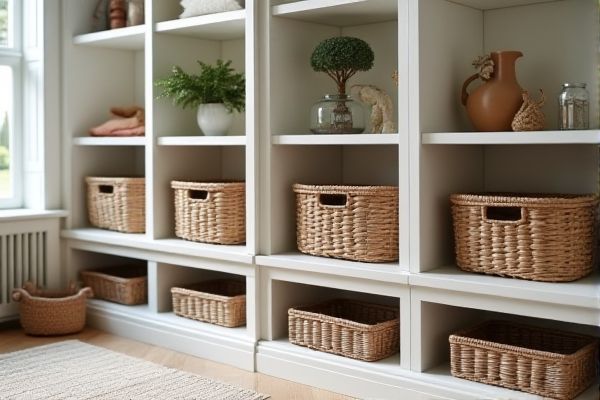
Cubby storage offers a structured, compartmentalized solution ideal for organizing items by category, while baskets provide a flexible, decorative option that can easily be moved or adjusted to suit changing storage needs. Explore the rest of the article to discover which option best enhances your space and organization style.
Table of Comparison
| Feature | Cubby Storage | Baskets |
|---|---|---|
| Structure | Fixed compartments or shelves | Flexible, portable containers |
| Material | Wood, metal, plastic | Wicker, fabric, plastic |
| Organization | Segmented storage for easy categorization | Bulk storage, less compartmentalized |
| Portability | Usually stationary | Easy to move and carry |
| Aesthetics | Modern, structured look | Casual, rustic or cozy appearance |
| Ideal Use | Organized item display and storage | Quick storage, easy transport |
| Cost | Varies, often higher due to fixed installation | Generally affordable and versatile |
Cubby Storage vs Baskets: An Overview
Cubby storage systems offer structured, open compartments ideal for organized and visible item placement, enhancing accessibility and maximizing space efficiency. Baskets provide flexible, portable storage often made from woven materials, suitable for containing loose or irregular items while adding texture and warmth to room decor. Choosing between cubby storage and baskets depends on the need for rigid organization versus adaptable, stylish containment.
Design and Aesthetic Differences
Cubby storage units offer a structured, grid-like design that enhances organization with visible compartments, often complementing modern or minimalist interiors through their clean lines and modular form. Baskets provide a softer, more versatile aesthetic with woven textures and natural materials like wicker or rattan, lending warmth and an organic feel to various decor styles. The choice between cubbies and baskets depends on desired visual impact: cubbies emphasize order and symmetry, while baskets add texture and a casual, cozy vibe.
Space Efficiency and Organization
Cubby storage maximizes space efficiency by offering multiple compartments that keep items separated and easily accessible, ideal for sorting toys, books, or office supplies. Baskets provide flexible storage options but often require more floor or shelf space and can lead to a less organized appearance without designated slots. Choosing cubby storage enhances organization by creating specific places for belongings, reducing clutter and improving visual tidiness compared to the more casual containment baskets offer.
Material and Durability Comparison
Cubby storage units are typically constructed from sturdy materials such as wood, metal, or high-density plastic, ensuring long-lasting durability and resistance to wear and tear. In contrast, baskets often use woven materials like rattan, wicker, or fabric, which can be less durable and more prone to damage from moisture or heavy loads. For heavy-duty storage needs, cubbies offer superior strength, while baskets excel in lightweight, flexible storage solutions.
Ease of Access and Use
Cubby storage offers clear visibility and easy access to items, allowing you to quickly locate and retrieve belongings without rummaging. Baskets, while flexible and decorative, may require more effort to sort through as contents can be less organized. For your daily use, cubbies provide a more straightforward and efficient system, especially in high-traffic areas or for frequently used items.
Versatility in Different Rooms
Cubby storage units provide structured compartments ideal for organizing items in entryways, kids' rooms, and offices, offering easy access and clear visibility. Baskets offer flexible, portable storage that adapts well to living rooms, bedrooms, and closets, enhancing decor while concealing clutter. Both solutions optimize space but cater to different organization styles and room functions, making versatility key when choosing between cubbies and baskets.
Cleaning and Maintenance Needs
Cubby storage typically requires minimal cleaning, as its open design allows dust to settle but is easily wiped down with a cloth. Baskets made from materials like wicker or fabric often need more intensive maintenance, including vacuuming or spot cleaning to remove dust and stains. Choosing between cubbies and baskets depends on the preferred cleaning routine and the level of maintenance one is willing to undertake.
Customization and Personalization Options
Cubby storage offers extensive customization and personalization options, allowing you to adjust compartments to fit specific items and add labels for easy organization. Baskets provide flexible decor choices with varied materials, colors, and sizes, but lack the structural adaptability of cubbies. Your choice depends on whether you prioritize tailored storage solutions or versatile decorative appeal.
Cost Considerations: Cubby Storage vs Baskets
Cubby storage units typically involve a higher upfront cost due to their rigid structure and materials like wood or metal, making them a longer-term investment compared to baskets. Baskets offer a budget-friendly alternative, often made from affordable materials such as wicker or fabric, allowing you to customize storage without significant expense. Your choice depends on balancing initial cost with durability and aesthetic preferences, as cubbies provide structured organization while baskets offer flexible, cost-effective solutions.
Choosing the Best Option for Your Home
Cubby storage offers structured organization and easy visibility, making it ideal for neatly sorting items like books, toys, or shoes in your home. Baskets provide flexible, portable storage solutions that add warmth and texture while hiding clutter, perfect for quick tidying or aesthetic appeal. Consider your space, accessibility needs, and style preferences to choose between the efficient compartmentalization of cubbies and the versatile charm of baskets for your home organization.
 homyna.com
homyna.com